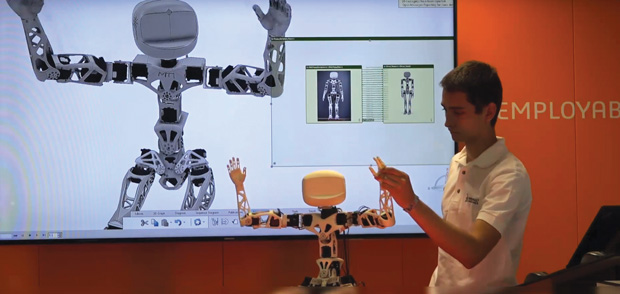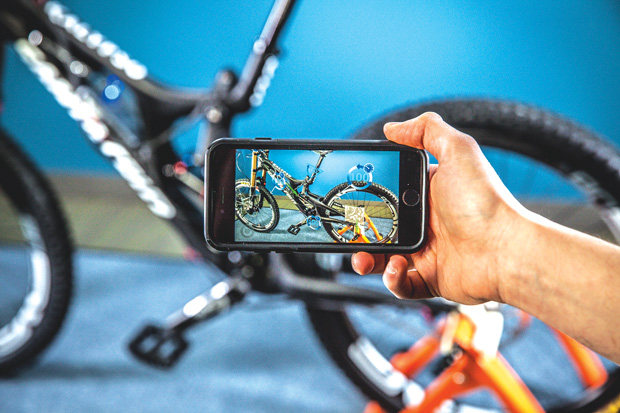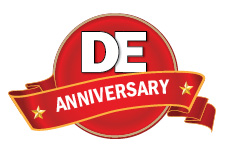
In partnership with the engineering school Arts & Métiers ParisTech (ENSAM), Dassault Systèmes’ Academia team developed a digital twin of an open-source humanoid robot, dubbed Poppy. Image courtesy of Dassault Systèmes.
Latest News
September 1, 2016
 In partnership with the engineering school Arts & Métiers ParisTech (ENSAM), Dassault Systèmes’ Academia team developed a digital twin of an open-source humanoid robot, dubbed Poppy. Image courtesy of Dassault Systèmes.
In partnership with the engineering school Arts & Métiers ParisTech (ENSAM), Dassault Systèmes’ Academia team developed a digital twin of an open-source humanoid robot, dubbed Poppy. Image courtesy of Dassault Systèmes.In the 2012 paper titled The Digital Twin Paradigm for Future NASA and U.S. Air Force Vehicles, coauthors E. H. Glaessgen from NASA Langley Research Center and D.S. Stargel from the Air Force Office of Scientific Research wrote that the digital twin is “an integrated multiphysics, multiscale, probabilistic simulation of an as-built vehicle or system that uses the best available physical models, sensor updates, fleet history, etc., to mirror the life of its corresponding flying twin.”
The term “digital twin” gained wider renown after LiveWorx 2015, a conference hosted by IoT software company PTC. The company used it to describe a digital replica driven by a real-time sensor data feed from its physical counterpart. Using 3D digital models to represent yet-to-be-built products in manufacturing is a long-established practice. But a digital twin, as demonstrated by PTC, took the practice a step further. By linking the digital model of a mountain bike to web-streamed sensor data (such as speed, torque and steering angle) from a real mountain bike, the company showed that a digital model could be configured to replicate the behaviors of a real product.
The CAD model, which expresses a product’s shape, is just one aspect of the digital twin. It provides the outer shell, but it must be animated with inputs from enterprise resource planning (ERP) systems, product lifecycle management (PLM) systems, real-time monitoring apps, and active sensors. What is the platform or environment in which a digital twin lives? There’s no easy answer to the question. It lives in the intersection of many software programs. Therefore, it spawns a whole new set of interoperability issues.
More Than CAD
A digital twin is much more than the digital construct of a product’s shape in curves, splines, surfaces and solids. It’s a dynamic digital model driven by real-time data coming from a product in the field, be it a mountain bike, a Humvee or a drone. The setup allows the virtual model to replicate the electromechanical behaviors of the physical counterpart. It’s a useful method to remotely monitor the health of the product, simulate its performance under hypothetical conditions, and even predict its potential failure.
In PTC’s demonstration at LiveWorx 2015, Mike Campbell, PTC’s executive VP of Vuforia Studio, used PTC Creo CAD software as the front-end for visualization. Sensor data from a real mountain bike was linked to the Creo CAD model via ThingWorx, PTC’s IoT software. “This demonstration illustrated how Creo can interact with the digital twin,” explains Francois Lamy, PTC’s VP of PLM solutions. “But CAD alone isn’t enough to build a digital twin. One of the main problems the digital twin needs to solve is to have a representation of the product as built, maintained and operated in the field.”
In June, Siemens PLM Software introduced Simcenter, described as “a suite of simulation software and test solutions that help companies address the modern engineering challenges of today’s complex products.” In addition, Siemens released Simcenter 3D, described as “3D CAE for the digital twin.” Ravi Shankar, Siemens PLM Software’s director of global simulation product marketing, says: “It would be dangerous to think of a digital twin as a single model. The pieces of technology involved in constructing your digital twin may depend on the answer you’re looking for.”
Eliane Fourgeau, systems director of Dassault Systèmes’ CATIA, says: “You cannot replicate the behaviors of a real product with hardware, software and sensors with a single environment. You need different technologies for different aspects of the digital twin. The sensors need to be modeled in a specialized modeling environment, the control software has to be modeled in another environment, and so on.”
 At LiveWorx 2015, PTC demonstrated its digital twin concept using the PTC Creo 3D CAD program for front-end visualization. Sensor data from the real bike was connected to the CAD model via PTC ThingWorx software. Shown here is a lightweight version of the digital twin presented in an augmented reality app. Image courtesy of PTC.
At LiveWorx 2015, PTC demonstrated its digital twin concept using the PTC Creo 3D CAD program for front-end visualization. Sensor data from the real bike was connected to the CAD model via PTC ThingWorx software. Shown here is a lightweight version of the digital twin presented in an augmented reality app. Image courtesy of PTC.The shape of the digital twin, as authored in a CAD program, could easily be transferred. Dassault Systèmes’ 3DEXPERIENCE Platform, PTC Creo CAD program and Siemens PLM Software’s Simcenter support industry-standard 3D exchange file formats, such as STEP, STL, IGES, OBJ, JT and others. That gives you the appearance of the twin, but not its soul—the sensor data from the field, simulation history, enterprise data and product lifecycle data that helps you predict when the product might fail or need maintenance.
The Data-Driven Soul
To keep the digital twin in sync with the real-time conditions of its physical counterpart, the digital model must be linked to the sensor readings from the field.
“What we’re talking about is a live connection between the digital model and the real object in the field though some type of sensors,” says Venkat Parameshwaran, VP of Product Management and Business Development at Altair. “Our simulation solvers in the HyperWorks and solidThinking Suites can interact with sensor signals, like thermal data, acceleration and such. But keep in mind that the data to feed the simulation model has to come through the cloud, so our products like Simulation Cloud Suites [for simulation lifecycle management], PBS Works Suites [for high-performance computing workload management] and ENVISION [for business intelligence and analytics] will come into play.”
PTC’s Lamy says: “The digital twin is delivered as a set of applications on top of the ThingWorx platform. PTC’s digital twin leverages information from PTC solutions, including Creo, Windchill, Integrity and SLM (service lifecycle management) solutions. It will also leverage information from other enterprise systems such as CRM, ERP, etc.”
“There’s no single file format for a digital twin, because it’s made from a conglomerate of programs. Simulation data management is a critical part of the digital twin,” says Patrick Farrell, senior marketing manager for Simulation and Test Solutions at Siemens PLM Software.
Shankar adds: “What you want to be able to do is very quickly pull together the right model, the right analysis tools, and the right load cases to answer a question. That’s why you need a solid data management backbone.”
Simcenter 3D comes with out-of-the-box integration with Teamcenter, the company’s data-management software. Perhaps more importantly, it integrates with Teamcenter Simulation Process Management. Currently Simcenter doesn’t have a mechanism to integrate directly with ERP or supply chain systems. “But we are looking into introducing Big Data analytics, in conjunction with simulation data,” explains Shankar.
The Tricky Link
At present, there’s no such thing as a standard sensor data format that can readily be imported into a 3D modeler for animation or simulation purpose. The void is a significant hurdle for those attempting to use sensor data to give life to a digital twin.
If the sensors in the field are capturing and transmitting raw image files (as with webcams), the burden to process the visual output and extract meaningful insight may rest with the data management or PLM program. In that case, robust data analytics will play a crucial role in distinguishing noise from useful patterns. If the sensors are collecting numeric values (such as hourly temperatures, speeds, acceleration and chemical buildup), they need to be sent to a simulation process management program. In that case, the software must have a mechanism that transforms such data into simulation inputs, such as heat loads, pressures and forces marked with directions.
“Once the data is transmitted to the cloud, it’s just a matter of translating it into a format understandable by a solver [in a simulation program],” says Altair’s Parameshwaran. “The missing piece is getting the data from the sensor to the [simulation automation] infrastructure. Here technologies like solidThinking EMBED (previously called VisSim) can help with its real-time monitoring with CAN, OPC and other real-time data acquisition boards.”
Colleague Stuart Sampson, VP of Modeling and Visualization at Altair, adds: “Today the data transfer is pretty much manual, whether it is ASCII file or binary file. Maybe in the future, there’ll be a live mechanism to push and pull data from the real world [captured by sensors] into the digital model.”
Siemens PLM Software’s Shankar says: “The industry is still in the early stage of understanding how to bring sensor data into 3D simulation. But I believe Siemens PLM Software has an advantage. We have expertise not just in building sensors but also in the data acquisition process, through our LMS brand.”
The LMS portfolio is the outcome of Siemens PLM Software’s acquisition of Belgium-based LMS, a developer of test and mechatronic simulation software. LMS Test.Lab offers the ability to incorporate high-speed multi-channel data acquisition into physical tests. Shankar added, “We can take the data captured in durability tests, such as those conducted by car makers, then convert the data into load cases for simulation software.”
The Simcenter portfolio also offers tools to create 1D system diagrams. “LMS Imagine.Lab Amesim is the 1D simulation tool within the Simcenter portfolio. To exchange simulation models between different authoring tools, we use the FMI, or Functional Mockup Interface [a standard for model exchange and co-simulation of dynamic models using XML-files and compiled C-code]. LMS Imagine.Lab Amesim supports two versions of this standard. In addition to FMI, LMS Imagine.Lab Amesim supports direct model exchange with MathWorks’ Simulink and can also perform co-simulation with Simulink and NI’s LabVIEW,” says Farrell.
A House for the Digital Twin
The visual representation of the digital twin will most likely be delegated to some type of 3D software. Standard CAD packages, simulation programs or lightweight 3D viewers might fit the bill, depending on the volume of data and degree of details involved.
“[The visualization program you use] really depends on the level of details you want to see,” says Altair’s Sampson. “If [the digital twin] is a full vehicle model, I would imagine you’d need something like HyperMesh/HyperView and HyperGraph. But if the model is more localized—a part or subsystem kept on a local machine—maybe SimLab or Inspire would be more appropriate.”
Non-experts may want to visualize the data in a lightweight viewer, but the industry has yet to adopt a single viewer that will show geometry and detailed simulation results, Altair’s Parameshwaran says.
“The idea is to have a representation that’s as close to the real thing in the field as possible,” Lamy says. “PTC Creo fits the purpose quite well, because it can consolidate several components of the product from different CAD formats into a single model. Some people might not want to use an engineering tool like CAD to view a digital twin. PTC Creo View or Vuforia can provide a lightweight representation.”
In late 2015, PTC acquired Vuforia, an AR platform, from a subsidiary of the telecom giant Qualcomm. The company explained the purchase as part of its strategy to provide “technologies and solutions that blend the digital and physical worlds.”
“Together with partners of the European MODELISAR project and the Modelica Association, we developed the FMI standard,” says Dassault Systèmes’ Forgeau. “With this standard, you can have a virtual representation of a complex system, including its multibody kinematics, deformations, mechanics, hydraulics, etc. and electronics. That’s the interface to connect a CATIA digital model to real-time sensor data.”
Open Data Exchange
Most vendors advocating or championing the digital twin paradigm have figured out ways to support and maintain such a model within their own software offerings, usually in a mix of CAD programs, system modeling tools and data management tools. But in reality, the model will most likely need to reside in a mixed-software environment where the underlying data structure is supported by software from a number of competing vendors and some custom codes developed in-house.
“Engineers can leverage Simcenter 3D’s best-in-class simulation modeling as a centralized pre- and post-processing environment to support Simcenter 3D’s own solvers (NX Nastran, LMS Samcef, Simcenter Thermal, Simcenter Flow, Simcenter Motion, Simcenter Acoustics BEM) as well as external solvers, like Abaqus, ANSYS, LS-DYNA and MSC Nastran,” says Farrell.
PTC’s Lamy says: “We can use CAD and PLM interoperability tools to bring the required information into the PTC solutions first and then leverage this information to create the digital twin representation.”
The fact that a digital twin is a composite portrait created from various data sources (sensors, PLM, ERP, CAD and CAE) presents an interoperability conundrum. It means there’s no easy way to transfer a digital twin in its entirety from one environment to another. You may, however, transfer different aspects of the model using the appropriate tools. For example, using 3D exchange formats to transfer the geometry, using XML formats to transfer the PLM and enterprise data, and so on.
Until the industry figures out a way to package such a model into a software-independent format with all of its history and parameters intact, the digital twin can’t travel. It will have to live where it’s created. Therefore, your choice of home for the digital twin is a commitment that warrants careful consideration.
More Info
Subscribe to our FREE magazine, FREE email newsletters or both!
Latest News
About the Author
Kenneth Wong is Digital Engineering’s resident blogger and senior editor. Email him at [email protected] or share your thoughts on this article at digitaleng.news/facebook.
Follow DE






